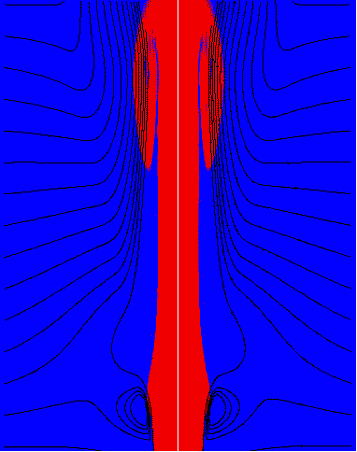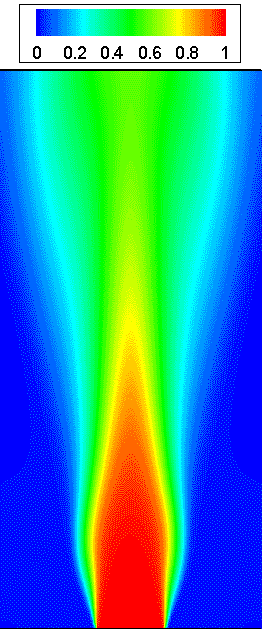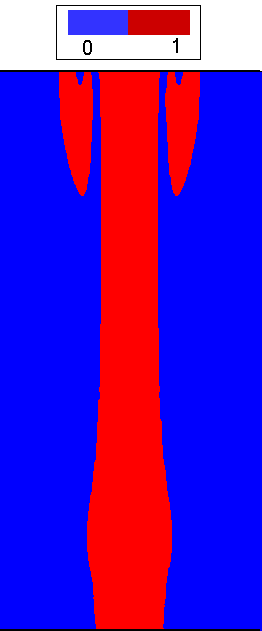Unsteady turbulent flows
Example: Calculation of an isothermal pulsed turbulent jet
| Background of the investigations was the calculation of the flame transfer functions of turbulent pulsed jet flames (see appropriate example).
The calculations were done with the CFD-code CATS-2d using the k-e turbulence model. The flow case was a turbulent free jet (air in air) with an outlet velocity of 25 m/s. The velocity at the nozzle outlet was modulated sinusoidally with a frequency of 80 Hz and an amplitude of 7 m/s. The nozzle diameter was 26 mm. The Reynoldsnumber was ca. 45000. At every acceleration of the flow, a turbulent ring vortex is formed at the outlet and flows downstream. All animations show the concentration of a passive scalar in the flow field (red = 100%, blue = 0%) for different conditions. The first animation shows the calculation with turbulent diffusion. This leads to an intensive mixture. The position and the shape of the ring vortex cannot be seen clearly. The analysis of the results yielded that the numerical diffusion is neglectible in this calculation. The second animation shows the calculation of the mixture field using a SLIC (Simple-Line-Interface-Convection)-Algorithm which was implemented into the code. Therefore it is possible to investigate the effect of convection of the tracer without any mixture effects (nor turbulent neither numerical diffusion). In this case the influence of the ring vortex can clearly be identified. The ring vortex leads to a spiral structure of the interface between nozzle and ambient fluid. |
 |
The third animation shows again the mixture field without diffusion, but now together with streamlines. These indicate the actual direction of the flow. It clearly can be seen, that the local velocity distribution shows a center moving downstream in time. But this is not the center of the vortex. This is proven by the fact, that the spriral structure is not rolled up round this center. The center of the vortex is marked by the relative streamfunction. More details of this interesting behavior can be found in the paper.
 |
 |
References
Hettel, M., Habisreuther, P., Weiß, H., Bockhorn, H., Zarzalis, N., (2005). URANS-Modelling of Pulsed Turbulent Jets and Premixed Jet Flames. Progress in Computational Fluid Dynamics (PCFD), 5, 386-397.
